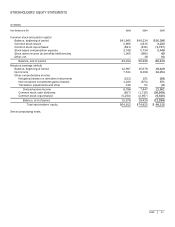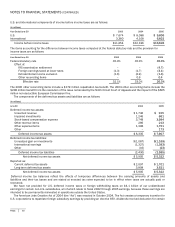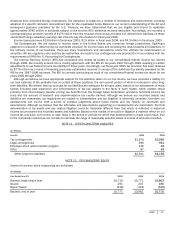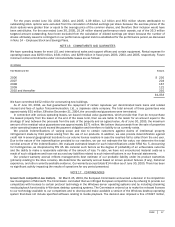Microsoft 2005 Annual Report Download - page 52
Download and view the complete annual report
Please find page 52 of the 2005 Microsoft annual report below. You can navigate through the pages in the report by either clicking on the pages listed below, or by using the keyword search tool below to find specific information within the annual report.
PAGE 51
dividends from controlled foreign corporations. The deduction is subject to a number of limitations and requirements, including
adoption of a specific domestic reinvestment plan for the repatriated funds. Based on our current understanding of the Act and
subsequent guidance published by the U.S. Treasury, we have determined that we are eligible and intend to repatriate
approximately $780 million in dividends subject to the elective 85% dividends received deduction. Accordingly, we recorded a
corresponding tax provision benefit of $179 million from the reversal of previously provided U.S. deferred tax liabilities on these
unremitted foreign subsidiary earnings. We intend to pay this dividend in fiscal year 2006.
Income taxes paid were $2.8 billion in fiscal year 2003, $2.5 billion in fiscal year 2004, and $4.3 billion in fiscal year 2005.
Tax Contingencies. We are subject to income taxes in the United States and numerous foreign jurisdictions. Significant
judgment is required in determining our worldwide provision for income taxes and recording the related assets and liabilities. In
the ordinary course of our business, there are many transactions and calculations where the ultimate tax determination is
uncertain. We are regularly under audit by tax authorities. Accruals for tax contingencies are provided for in accordance with the
requirements of SFAS No. 5, Accounting for Contingencies.
The Internal Revenue Service (IRS) has completed and closed its audits of our consolidated federal income tax returns
through 1996. We recently entered into a closing agreement with the IRS for tax years 1997 through 1999 resulting in certain
adjustments to our federal income tax liability for those years. Accordingly, our fiscal year 2005 tax provision has been reduced
by $776 million as a result of reversing previously established reserves in excess of the additional tax liability assessed by the
IRS for the 1997-1999 tax years. The IRS is currently conducting an audit of our consolidated federal income tax return for tax
years 2000 through 2003.
Although we believe we have appropriate support for the positions taken on our tax returns, we have recorded a liability for
our best estimate of the probable loss on certain of these positions, the non-current portion of which is included in other long-
term liabilities. We believe that our accruals for tax liabilities are adequate for all open years, based on our assessment of many
factors including past experience and interpretations of tax law applied to the facts of each matter, which matters result
primarily from intercompany transfer pricing, tax benefits from the Foreign Sales Corporation and Extra Territorial Income tax
rules and the amount of research and experimentation tax credits claimed. Although we believe our recorded assets and
liabilities are reasonable, tax regulations are subject to interpretation and tax litigation is inherently uncertain; therefore our
assessments can involve both a series of complex judgments about future events and rely heavily on estimates and
assumptions. Although we believe that the estimates and assumptions supporting our assessments are reasonable, the final
determination of tax audits and any related litigation could be materially different than that which is reflected in historical
income tax provisions and recorded assets and liabilities. Based on the results of an audit or litigation a material effect on our
income tax provision, net income, or cash flows in the period or periods for which that determination is made could result. Due
to the complexity involved we are not able to estimate the range of reasonably possible losses in excess of amounts recorded.
NOTE 11 OTHER LONG-TERM LIABILITIES
(In millions)
June 30
2004 2005
Tax contingencies $1,979
$3,066
Legal contingencies 699
961
Employee stock option transfer program 146
48
Other 87
83
Other lon
g
-
t
erm liabilities $2,911
$4,158
NOTE 12 STOCKHOLDERS’ EQUITY
Shares of common stock outstanding are as follows:
(In millions)
Y
ear Ended June 30
2003
2004
2005
Balance, beginning of year
10,718
10,771
10,862
Issued
291
215
160
Repurchased
(238) (124)
(312)
Balance, end of year
10,771
10,862
10,710
























